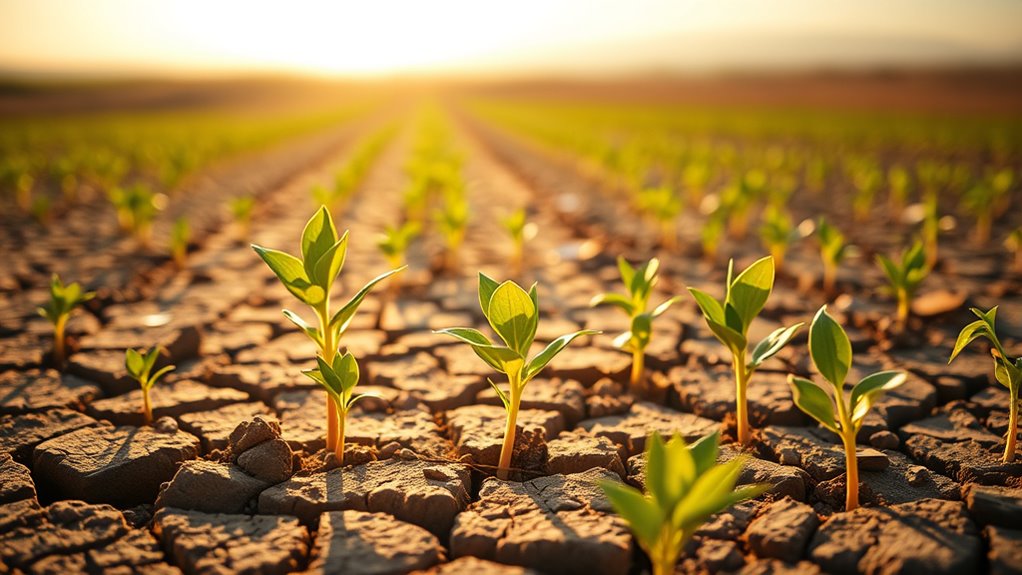AI-driven breeding is revolutionizing how you develop drought-resistant seeds, helping crops survive in water-scarce conditions. By analyzing vast genetic data and environmental factors, AI predicts the best gene combinations to boost drought tolerance. This accelerates creating resilient varieties tailored to specific regions, ensuring high yields despite drought stress. If you want to see how this technology is shaping sustainable farming and food security, keep exploring the exciting possibilities ahead.
Key Takeaways
- AI analyzes genetic data to identify genes linked to drought tolerance, accelerating seed development.
- AI predicts optimal genetic combinations, enabling precise breeding for drought-resistant crops.
- Genetic modification combined with AI streamlines creation of resilient seeds suited to diverse environments.
- AI-driven methods reduce time and resources needed to develop high-yield, drought-tolerant crop varieties.
- Enhanced crop resilience supports sustainable agriculture amid climate change and water scarcity challenges.

Have you ever wondered how farmers can grow crops during prolonged droughts? It’s a question many people ask as climate change intensifies, making water scarcity a harsh reality for agriculture worldwide. The answer lies in innovative breeding techniques, especially those driven by artificial intelligence (AI). These advancements enable scientists to develop drought-resistant seeds that thrive even when water is scarce. One of the key tools used in this process is genetic modification, which allows for precise alterations to a plant’s DNA, giving it traits that enhance drought tolerance. This form of climate adaptation isn’t just about surviving in dry conditions; it’s about transforming crops to withstand the stresses caused by changing climates. Through genetic modification, scientists can insert or tweak specific genes responsible for water efficiency, root growth, and stress response, creating seeds that are inherently more resilient. AI accelerates this process by analyzing vast amounts of genetic data to identify the most promising gene targets for drought resistance. Instead of relying on traditional trial-and-error breeding, AI models predict which genetic combinations will produce the best outcomes, saving time and resources. This integration of AI and genetic modification means that drought-resistant seeds can be tailored to different environmental conditions, ensuring they perform well in diverse regions. As a result, farmers gain access to crops that require less water, reducing reliance on irrigation and helping to conserve water resources. Furthermore, these seeds often exhibit improved nutrient use efficiency, making them more productive in poor soils that are common in drought-affected areas. The development process involves complex data analysis, where AI algorithms sift through genetic information, environmental factors, and crop performance to identify ideal traits. Once identified, these traits are incorporated into new seed varieties using genetic modification techniques. The end goal is to produce seeds that not only survive drought conditions but also maintain high yields, ensuring food security for communities facing water shortages. This approach also encourages sustainable farming practices, as it minimizes the need for extensive water use and chemical inputs. Overall, the combination of AI-driven breeding and genetic modification is revolutionizing how we approach climate adaptation in agriculture. It empowers farmers to grow resilient crops despite the challenges posed by a changing climate. By investing in these technologies, we’re taking significant steps toward a future where food production can keep pace with environmental stresses, safeguarding livelihoods and feeding a growing global population.
Frequently Asked Questions
How Do AI Algorithms Identify Drought-Resistant Traits in Seeds?
You can see AI algorithms identify drought-resistant traits by analyzing genetic markers linked to resilience. They process vast genetic data to spot patterns and perform trait identification accurately. This helps you select seeds with the desired drought-tolerance traits, increasing crop resilience. The algorithms quickly evaluate numerous genetic variations, enabling more efficient breeding programs and ensuring you grow crops better suited to withstand water shortages.
What Are the Environmental Impacts of Ai-Driven Seed Development?
You might find that AI-driven seed development can gently influence environmental health. While it helps boost crop resilience, it’s essential to take into account its impact on genetic diversity and ecological balance. By promoting sustainable practices, you can ensure that innovations support diverse ecosystems and prevent unintended disruptions. Embracing responsible AI use safeguards nature’s harmony, ensuring that advancements benefit both agriculture and the environment without compromising ecological stability.
Can AI Predict Long-Term Climate Effects on Crop Resilience?
Yes, AI can predict long-term climate effects on crop resilience by using climate modeling to analyze future scenarios. You can leverage AI-driven data to identify patterns and assess how crops will adapt to changing conditions over time. This helps in developing strategies for crop adaptation, ensuring food security. By understanding potential climate impacts, you can make smarter decisions about breeding resilient crops for a sustainable future.
How Accessible Are Ai-Driven Seed Technologies to Small-Scale Farmers?
AI-driven seed technologies are becoming more accessible to small-scale farmers through targeted farmer education and expanded seed distribution channels. You’ll find programs that teach you how to use these advanced seeds effectively, while local suppliers and cooperatives help distribute them affordably. As awareness grows, more initiatives aim to bridge the gap, ensuring you can access resilient seeds that improve your crop yields and climate adaptability without breaking your budget.
What Ethical Considerations Are Involved in Ai-Based Crop Breeding?
Did you know that over 70% of global food crops rely on a limited genetic pool? When it comes to AI-based crop breeding, ethical concerns like maintaining genetic diversity and managing intellectual property rights come into play. You need to take into account whether AI favors big corporations over small farmers, potentially leading to monopolies. Ensuring fairness and protecting biodiversity are vital to ethically advancing AI-driven agriculture.
Conclusion
As you walk through the fields of the future, AI-driven breeding acts like a skilled navigator, guiding crops through the harshest droughts. These resilient seeds are like sturdy ships weathering stormy seas, ensuring your food supply remains steady and strong. With each breakthrough, you’re witnessing a new dawn where technology and nature unite, transforming barren lands into lush tapestries of life. Embrace this crop revolution—it’s the seed of hope sprouting in every dry corner.









